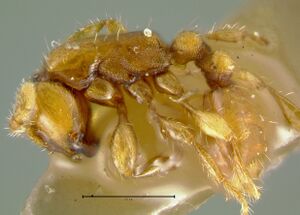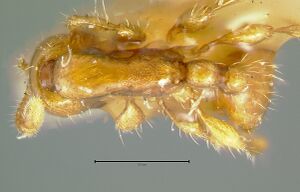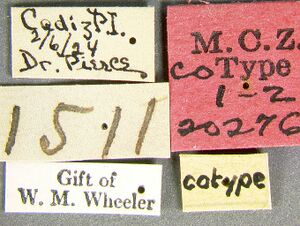Aenictus piercei
| Aenictus piercei | |
|---|---|

| |
| Scientific classification | |
| Kingdom: | Animalia |
| Phylum: | Arthropoda |
| Class: | Insecta |
| Order: | Hymenoptera |
| Family: | Formicidae |
| Subfamily: | Dorylinae |
| Genus: | Aenictus |
| Species: | A. piercei |
| Binomial name | |
| Aenictus piercei Wheeler, W.M. & Chapman, 1930 | |
Little is known about the bionomics of A. piercei. Nothing is mentioned by Wheeler (1930), however, judging from the hitherto known localities (Negros and Mindanao) (see Wilson 1964) this species inhabits lowland (15-600 m) and is probably restricted to the Philippines. Wilson (1964) cited India, Solon (ca. 1400 m), as a locality of A. piercei, but the identification should be reconfirmed.
Identification
A member of the javanus species group. This species is most similar to Aenictus duengkaei (see under A. duengkaei for differences).
Keys including this Species
Distribution
Latitudinal Distribution Pattern
Latitudinal Range: 22.88333333° to 12.766089°.
| North Temperate |
North Subtropical |
Tropical | South Subtropical |
South Temperate |
- Source: AntMaps
Distribution based on Regional Taxon Lists
Indo-Australian Region: Philippines (type locality).
Oriental Region: India.
Palaearctic Region: China.
Distribution based on AntMaps
Distribution based on AntWeb specimens
Check data from AntWeb
Countries Occupied
| Number of countries occupied by this species based on AntWiki Regional Taxon Lists. In general, fewer countries occupied indicates a narrower range, while more countries indicates a more widespread species. |

|
Estimated Abundance
| Relative abundance based on number of AntMaps records per species (this species within the purple bar). Fewer records (to the left) indicates a less abundant/encountered species while more records (to the right) indicates more abundant/encountered species. |

|
Biology
Castes
Known only from the worker caste.
   
| |
| . | Owned by Museum of Comparative Zoology. |
Nomenclature
The following information is derived from Barry Bolton's Online Catalogue of the Ants of the World.
- piercei. Aenictus (Aenictus) piercei Wheeler, W.M. & Chapman, in Wheeler, W.M. 1930g: 209, fig. 7e-g (w.) PHILIPPINES (Negros).
- Type-material: lectotype worker (by designation of Jaitrong & Yamane, 2012: 63), 1 paralectotype worker.
- Type-locality: lectotype Philippines: Negros, Cadiz, 2.vi.1924 (W.D. Pierce); paralectotype with same data.
- Type-depository: MCZC.
- Status as species: Chapman & Capco, 1951: 11; Chapman, 1963: 262; Wilson, 1964a: 474; Baltazar, 1966: 231; Bolton, 1995b: 60; Bharti, Wachkoo & Kumar, 2012: 293 (in key); Guénard & Dunn, 2012: 23; Jaitrong & Yamane, 2012: 63 (redescription); Bharti, Guénard, et al. 2016: 21.
- Distribution: Philippines (Mindanao, Negros).
Unless otherwise noted the text for the remainder of this section is reported from the publication that includes the original description.
Description
Worker
Wilson (1964) - Dumaguete: HW 0.46 mm, HL 0.51 mm, SL 0.27 mm. (Syntype: HW 0.44 mm; only HW could be measured in this specimen). Antenna 10-segmented; scape exceptionally short and incrassate. Mandibles narrow, 3- or 4-toothed; on closure, not separated by a gap from the anterior clypeal border. Clypeus convex, entire, unarmed. Parafrontal ridge lacking. Occiput very feebly convex. Basal face of propodeum straight. Propodeal junction evenly rounded. Femora incrassate, a distinctive character. Subpetiolar process proportionately very large, consisting of a symmetrical, downward directed lobe surmounted by a flange whose major angle is about 80° and projects posteriorly. Pilosity moderately abundant; length of longest pronotal hairs about 0.10 mm.
Head shining. Pronotum shining; remainder of mesosoma microreticulate (reticular diameters about 0.008 mm), dorsum feebly shining and sides microreticulate and subopaque. Concolorous medium yellow.
Jaitrong & Yamane (2012) - Lectotype: TL 2.15 mm; HL 0.53 mm; HW 0.48 mm; SL 0.28 mm; ML 0.70 mm; PL 0.20 mm; CI 90; SI 58.
Paralectotypes (n = 2): TL 2.15 mm; HL 0.53-0.58 mm; HW 0.48-0.50 mm; SL 0.28-0.33 mm; ML 0.70-0.83 mm; PL 0.20-0.23 mm; CI 87-90; SI 58-65.
Head in full-face view slightly longer than broad, subrectangular, with sides feebly convex and posterior margin almost straight; seen in profile occipital corner of head rounded. Antennal scape reaching midlength of head; antennal segment II longer and narrower than each of III–VI; terminal segment almost as long as VII+VIII+IX and 1.9 times as long as broad. Anterior margin of clypeus bearing 9-10 denticles (this observation is based on the single non-type worker, since in the lectotype mouth parts are buried in glue and the head of the paralectotype was missing). Masticatory margin of mandible with 3 acute teeth including large apical tooth; basal margin lacking denticles. Promesonotum in profile almost flat dorsally; in profile propodeum almost flat dorsally; propodeal junction angulate, right-angled; declivity of propodeum nearly flat, with blunt lateral carinae, but not demarcated basally by a transverse carina. Petiole almost as long as high, its dorsal outline convex; subpetiolar process well developed, subrectangular, its ventral margin slightly convex and longer than posterior margin; postpetiole almost as long as petiole.
Head including antennal scape entirely smooth and shiny. Mandible finely striate except along masticatory and outer margins. Pronotum entirely smooth and shiny except for anteriormost part microreticulate; mesonotum smooth and shiny; mesopleuron, metapleuron and propodeum microreticulate. Petiole entirely microreticulate. Postpetiole microreticulate except for a small smooth and shiny area on dorsal surface.
Head and mesosoma dorsally with relatively sparse standing hairs mixed with sparse short hairs; longest pronotal hairs 0.09-0.10 mm long. Entire body yellowish brown or reddish brown; legs palest.
Type Material
Described from two specimens taken by Dr. W. D. Pierce at Cadiz, P. I.
Jaitrong & Yamane (2012) - Two syntype workers on a pin, the Philippines, Negros, Cadiz, 2.VI.1924, leg. Dr. Pierce (Museum of Comparative Zoology, examined). The worker located below on the pin is selected as the lectotype.
References
- Chapman, J. W.; Capco, S. R. 1951. Check list of the ants (Hymenoptera: Formicidae) of Asia. Monogr. Inst. Sci. Technol. Manila 1: 1-327 (page 11, checklist)
- Jaitrong, W. & Yamane, S. (2012) Review of the Southeast Asian species of the Aenictus javanus and Aenictus philippinensis species groups (Hymenoptera, Formicidae, Aenictinae). ZooKeys 193: 49–78, doi: 10.3897/zookeys.193.2768.
- Liu, C., Fischer, G., Hita Garcia, F., Yamane, S., Liu, Q., Peng, Y.Q., Economo, E.P., Guénard, B., Pierce, N.E. 2020. Ants of the Hengduan Mountains: a new altitudinal survey and updated checklist for Yunnan Province highlight an understudied insect biodiversity hotspot. ZooKeys 978, 1–171 (doi:10.3897/zookeys.978.55767).
- Wheeler, W. M. 1930j. Philippine ants of the genus Aenictus with descriptions of the females of two species. J. N. Y. Entomol. Soc. 38: 193-212 (page 209, fig. 7 worker described)
- Wilson, E. O. 1964a. The true army ants of the Indo-Australian area (Hymenoptera: Formicidae: Dorylinae). Pac. Insects 6: 427-483 (page 474, see also)
References based on Global Ant Biodiversity Informatics
- Borowiec M. L. 2016. Generic revision of the ant subfamily Dorylinae (Hymenoptera, Formicidae). ZooKeys 608: 1–280.
- Chapman J. W. 1965. Studies on the ecology of the army ants of the Philippines genus Aenictus Schuckard (Hymenoptera: Formicidae). Philippine Journal of Science. 93: 551-595.
- Chapman, J.W. and S.R. Capco. 1951. Check list of the ants (Hymenoptera: Formicidae) of Asia. Monographs of the Institute of Science and Technology (Manila) 1: 1- 327
- Chen Y. Q., Q. Li, Y. L. Chen, Z. X. Lu, X. Y. Zhou. 2011. Ant diversity and bio-indicators in land management of lac insect agroecosystem in Southwestern China. Biodivers. Conserv. 20: 3017-3038.
- Guénard B., and R. R. Dunn. 2012. A checklist of the ants of China. Zootaxa 3558: 1-77.
- Jaitrong, W., and S. Yamane. "Review of the Southeast Asian species of the Aenictus javanus and Aenictus philippinensis species groups (Hymenoptera, Formicidae, Aenictinae)." ZooKeys 193 (2012): 49-78.
- Song Y., Z Xu, C Li, N. Zhang, L. Zhang, H. Jiang, and F Mo. 2013. An analysis on the ant fauna of the Nangun River Nature Reserve in Yunnan, China. Forest Research 26(6): 773-780.
- Song Y., Z. Xu, C. Li, N. Zhang, L. Zhang, H. Jiang, and F. Mo. 2013. An Analysis on the Ant Fauna of the Nangun river Nature Reserve in Yunnan, China. Forest Research 26(6): 773-780.
- Xu Z. 1998. A report of fourty-one ant species newly recorded in China from Xishuangbanna District of Yunnan Province (Hymenoptera: Formicidae). Zhongguo Xue Shu Qi Kan Wen Zhai 4: 1119-1121.


